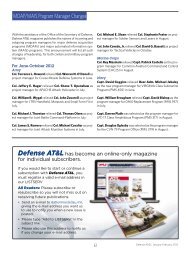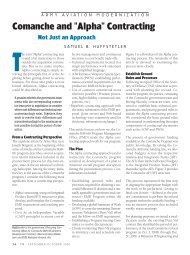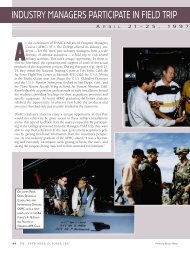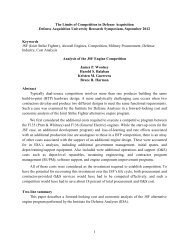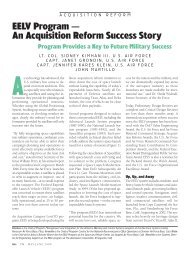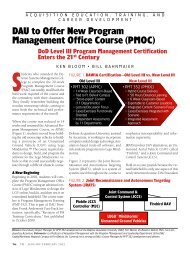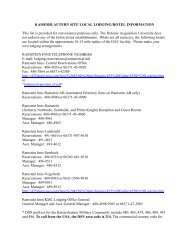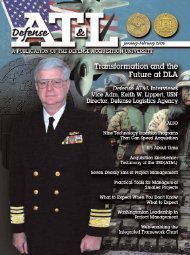Defense ARJ - Defense Acquisition University
Defense ARJ - Defense Acquisition University
Defense ARJ - Defense Acquisition University
Create successful ePaper yourself
Turn your PDF publications into a flip-book with our unique Google optimized e-Paper software.
<strong>Defense</strong> <strong>Acquisition</strong> Review Journal<br />
Episodic strategic planning under complex conditions is analogous to trying to<br />
play chess with all the moves planned out in advance. Modelers of complexity have<br />
calculated that there are 10 120 possible variations in chess moves possible in a single<br />
game. Mitchell Waldrop in his 1992 book, Complexity, suggests this “was a number<br />
so vast [as] to defy all metaphor. There haven’t been that many microseconds since<br />
the Big Bang” (p. 151). He goes on to say, “We human players have to make do with<br />
rules of thumb—hard learned heuristic guides that tell us what kind of strategies will<br />
work best in a given situation” (p. 151). John H. Holland, in his 1998 book Emergence,<br />
discusses the extraordinary complexity of chess.<br />
156<br />
Chess … has enough emergent properties that [it] continues to<br />
intrigue us and offer new discoveries after centuries of study. And it<br />
is not just the sheer number of possibilities. There are lines of play<br />
and regularities that continue to emerge after years of study, enough<br />
so that a master of this century would handily beat a master of the<br />
previous century (p. 23).<br />
The point is that chess, with only a dozen or so rules, creates extraordinary<br />
complexity that defies prediction. In much more complex situations involving national<br />
defense, how can planners expect to map strategies when the “rules” not only<br />
are difficult to discern, but which change dynamically in a short period of time? To<br />
substantiate this doubt, have <strong>Defense</strong> planners gone back to historic plans to judge<br />
how accurately past objectives met the needs of the future?<br />
Episodic strategic planning under complex conditions is<br />
analogous to trying to play chess with all the moves planned<br />
out in advance.<br />
The 1993 Report of the Bottom-Up Review (the precursor to the quadrennial<br />
review process) had only one force structure counter-terrorism task envisioned during<br />
“peace enforcement and intervention operations.” The task was too vague to tie to any<br />
specific program or budget: “securing protected zones from internal threats, such as<br />
snipers, terrorist attacks, or sabotage” (Aspin, 1993, p. 47). A later example includes<br />
the 1997 U.S. National Security Strategy for a New Century. This plan had a section<br />
on transnational threats that grouped terrorism along with drug trafficking and<br />
international crime. Counter-terrorism goals were addressed in the following sentence<br />
(parenthetical alphabetical letters represent emphases added):



